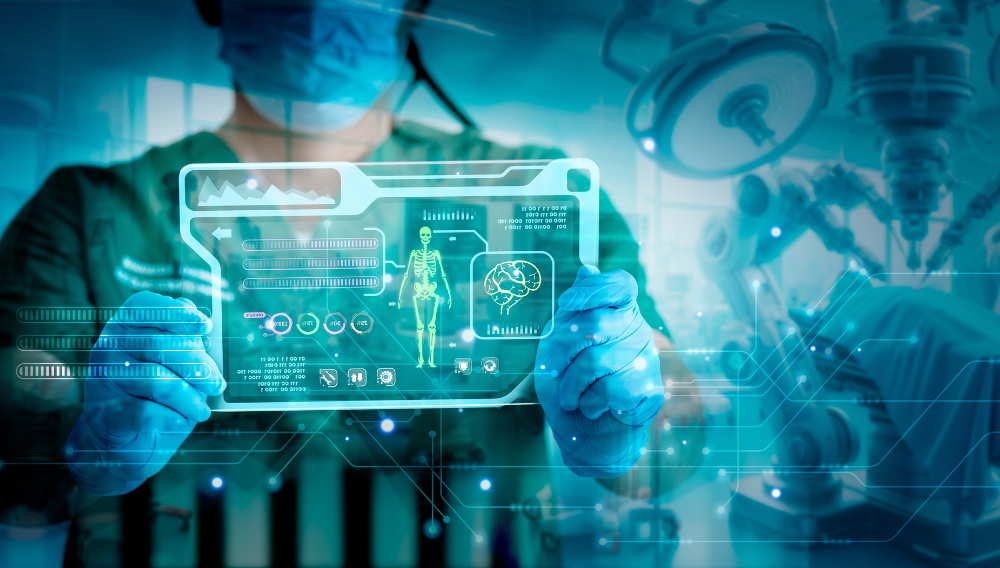3 min read
AI in Healthcare: Building the Software Infrastructure for Intelligent, Real-Time Data Streaming
 Akkshaj Singh
:
September 10, 2024
Akkshaj Singh
:
September 10, 2024

In the ever-evolving landscape of healthcare, technology continues to play a pivotal role in revolutionizing traditional surgical practices. One such groundbreaking advancement is the integration of Artificial Intelligence (AI) into surgical procedures, ushering in an era of unprecedented precision and safety. Imagine a scenario where every incision, every movement is guided by a seamless blend of human expertise and AI-powered assistance, tailored to the unique anatomy of each patient. This isn't science fiction; it's the reality unfolding in operating rooms around the world today.
Clinical teams are now adopting the latest technologies in the operating room to monitor, view, and control advanced applications and robotic devices to assist in procedures. When it comes to life-saving surgery, every decision, every movement and every millisecond counts. Surgical data can play a crucial role, offering surgeons invaluable information and precise feedback on surgical tasks, instrument performance, and patient anatomy.
Thanks to new developments in AI, video streams can also be augmented with intelligent overlays, providing additional context such as organ mapping, blood flow visualization, or highlighting areas of potential concern for the surgical team. However, any intelligent algorithm is only as good as the data you give it. When performing surgery, there is little to no margin for error or latency.
To truly enable this intelligent future, intelligent medical systems need to be able to process not only video, but also a variety of surgical metadata in real time. The fusion of video and other surgical data enable intelligent applications that provide real-time surgical feedback and guidance. These systems must do so in a distributed fashion, by communicating with other devices in the operating room that leverage various sensors, data, and applications. These interconnected systems must also be highly reliable and cybersecure, without compromising performance.
Instead of relying on cloud or centralized data centers, these systems must process real-time data from a number of sources closer to the data-generating applications, at the edge. However, legacy device architectures are not designed with the digital communication infrastructure required to integrate new technologies and satisfy interoperability, latency, reliability, and cybersecurity requirements.
RTI Connext for real-time, data-centric connectivity
RTI Connext is based on the Data Distribution Service (DDS™) standard. It streamlines connectivity across complex and scalable systems with a distributed, real-time software communication framework. Connext provides a data-centric communication architecture, whereby applications share data through a global data model, which represents a paradigm shift over traditional message-centric architectures.

Data centricity enables real-time information exchange between complex system components, while enabling stringent reliability, cybersecurity, and performance requirements. It also provides a framework to process, analyze and act on high-volume, real-time data with low latency in a redundant, fault-tolerant architecture. For streaming video, the RTI Connext Gstreamer Plugin extends the benefits of the framework to video data (e.g., discovery, fine-grained security, filtering) and streamlines the synchronization of video to correlated metadata.
The data-centric Connext framework enables modular, future-proof applications that are compatible with legacy and next-generation communication interfaces, across subsystems, devices, and platforms.
RTI Connext and NVIDIA Holoscan
To assist with developing these complex AI medical systems as efficiently as possible, RTI has collaborated with NVIDIA® to integrate RTI Connext with NVIDIA Holoscan®. Holoscan provides an AI computing platform that delivers real-time processing of streaming data. With Connext, you can have multiple Holoscan applications processing video and sensor data, and still have them communicate seamlessly in real time.
Click Image for Larger View
The integration of Connext with Holoscan enables developers to transform existing legacy applications into flexible, AI-enabled software-defined systems. Now, even device platforms that do not natively support Holoscan can still take advantage of its powerful capabilities and leverage a smart connectivity infrastructure.
For example, these capabilities can be applied to a significant portion of existing medical devices that are currently Windows-based (particularly in the domain of medical imaging), where Holoscan is not natively supported. By using Holoscan in a distributed system with Connext, advanced AI capabilities may be enabled on medical applications running real-time operating systems (RTOS) on non-native NVIDIA architectures. Lastly, sensor-based platforms (such as those used for patient monitoring) may now be augmented with powerful AI algorithms, even when the hardware or software making up the legacy system would otherwise limit the addition of such new capabilities.
Summary
The technological capabilities of RTI Connext provide an ideal platform for developing complex and intelligent medical systems. Real-time data streaming in the operating room and beyond is ushering in a new wave of devices that empower and assist real-time decision-making, intraoperative guidance, and automation. By providing clinical teams with integrated and AI-enabled systems, the future of healthcare is ideally positioned to deliver better outcomes, clinical efficiencies, and improved patient care.
To learn more about RTI in healthcare and medical devices, please click here.
About the author:
 Akkshaj Singh is an Application Engineer at RTI with a focus on New Commercial Markets and Security. He has a background in robotics and embedded systems, and is excited to work at the forefront of enabling autonomy.
Akkshaj Singh is an Application Engineer at RTI with a focus on New Commercial Markets and Security. He has a background in robotics and embedded systems, and is excited to work at the forefront of enabling autonomy.
He holds a BS in Electrical Engineering from the University of Washington, Seattle.
Posts by Tag
- Developers/Engineer (177)
- Connext DDS Suite (77)
- Technology (74)
- News & Events (73)
- 2020 (54)
- Standards & Consortia (51)
- Aerospace & Defense (48)
- Automotive (35)
- 2023 (34)
- 2022 (29)
- IIoT (27)
- Leadership (24)
- 2024 (22)
- Cybersecurity (20)
- Healthcare (20)
- 2021 (19)
- Connectivity Technology (15)
- Military Avionics (15)
- Culture & Careers (14)
- FACE (13)
- Connext DDS Pro (10)
- JADC2 (10)
- ROS 2 (10)
- 2025 (7)
- Connext DDS Tools (7)
- Connext DDS Micro (6)
- Databus (6)
- Transportation (5)
- Case + Code (4)
- Connext DDS (4)
- Connext DDS Cert (4)
- Energy Systems (4)
- FACE Technical Standard (4)
- Oil & Gas (3)
- RTI Labs (3)
- Research (3)
- Robotics (3)
- #A&D (2)
- Connext Conference (2)
- Edge Computing (2)
- MDO (2)
- MS&T (2)
- TSN (2)
- ABMS (1)
- C4ISR (1)
- ISO 26262 (1)
- L3Harris (1)
- LabView (1)
- MathWorks (1)
- National Instruments (1)
- Simulation (1)
- Tech Talks (1)
- UAM (1)
- Videos (1)
- eVTOL (1)
 Success-Plan Services
Success-Plan Services